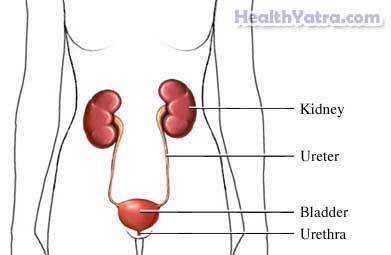تعريف
Vesicoureteral reflux (VUR) is the backward flow of urine. The urine flows from the bladder back into the kidney.
Urine normally flows from the kidneys. It passes through tubes called ureters. It then flows into the bladder. Each ureter connects to the bladder in a way that prevents urine from flowing back up the ureter. The connection is similar to a one-way valve. When this does not work properly, or if the ureters do not extend far enough into the bladder, urine may flow back up to the kidney. If the urine contains bacteria, the kidney may become infected. The back-up can also put extra pressure on the kidney. This can cause kidney damage.
This is a potentially serious condition that requires care from a doctor. Early treatment and prevention of infections can lead to better outcomes. If you suspect you have this condition, contact your doctor immediately.

أسباب
This condition may be caused by:
- A problem in the way the ureter inserts into the bladder
- A ureter that does not extend far enough into the bladder
- A bladder outlet obstruction (eg, blockage of urine flow from an enlarged prostate gland)
- A neurogenic bladder (loss of normal bladder function due to damaged nerves reaching the bladder)
- Temporary swelling after kidney transplant
عوامل الخطر
Factors that increase your chance of developing VUR include:
- تاريخ العائلة
- Congenital abnormalities of the urinary tract
- Birth defects that affect the spinal cord, such as السنسنة المشقوقة
- Tumors in the spinal cord or pelvis
- اصابة الحبل الشوكي
الأعراض
In most cases, VUR has no obvious symptoms or signs. In some cases, VUR is found after a urinary tract or kidney infection is diagnosed. Symptoms of urinary tract infections include:
- الحاجة المتكررة والملحة للتبول
- Passing small amounts of urine
- Pain in the abdomen or pelvic area
- الإحساس بالحرقان أثناء التبول
- بول غائم وذو رائحة كريهة
- زيادة الحاجة إلى الاستيقاظ ليلاً للتبول
- دم في البول
- تسرب البول
- Low back pain or pain along the side of the ribs
- حمى وقشعريرة
A prenatal ultrasound may show a swelling of the kidneys. This is calledhydronephrosis. It may indicate VUR.
التشخيص
سوف يسألك طبيبك عن أعراضك وتاريخك الطبي. اختبار فيزياء سوف يتم. قد تشمل الاختبارات ما يلي:
- تحاليل الدم
- اختبارات البول
- الموجات فوق الصوتية
- الاشعة المقطعية
- Voiding cystourethrogram (VCUG)—a liquid that can be seen on x-rays is placed in the bladder through a catheter; x-rays are taken when the bladder is filled and when urinating.
- Intravenous pyelogram—a liquid that can be seen on x-rays is injected into a vein; x-ray images are taken as the liquid travels from the blood (after being injected into a vein) into the kidneys and bladder
- Nuclear scans—a variety of tests using radioactive materials injected into a vein or the bladder to show how well the urinary system is working
In rare cases, high blood pressure may be an indication of kidney damage.
العلاج
The goal for treatment of VUR is to prevent any permanent kidney damage. Treatment options include the following:
جراحة
Endoscopic Injection Into the Ureter
This procedure is a minimally invasive surgery. It is done to correct the reflux. A gel is injected where the ureter inserts into the bladder. This can prevent urine from going back up the ureter. This procedure is done through a small tube called acystoscope.
Ureteral Reimplantation
This is a surgery that repositions the ureters in the bladder. This can be done in two ways. One way requires making an incision above the pubic bone and repositioning the ureters in the bladder. It can also be done laparoscopically by inserting cameras through small incisions in the abdomen and/or bladder to perform the surgery.
الوقاية
VUR cannot be prevented in most cases. However, further complications can be avoided. Seek prompt treatment for bladder or kidney infections. This is particularly important if you have a neurogenic bladder.
